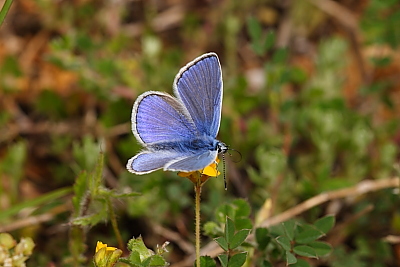

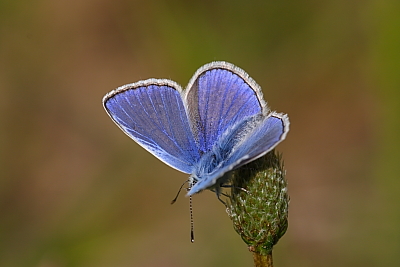
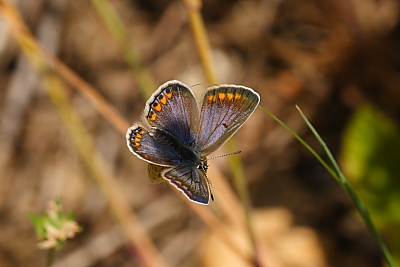


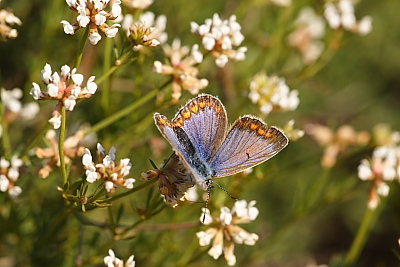










Common
Blue
2025 photographs highlighted in green. Click on any photograph to go to an enlarged picture, or simply scroll down the page.
|
A very common and very widespread blue, probably the most common in Europe. It is quite variable and, from the underside alone, could easily be confused with several of its Polyommatus cousins. The male upperside is fairly constant, although worn specimens can appear darker blue in flight. The male upperside black marginal line is usually thinner than the Chapman's Blue (P. thersites) and other differences are outlined on the thersites page.
Females can vary greatly with regard to the amount of upperside blue scaling, varying from brown with almost no blue, to extensive blue, with almost anything in between. The female underside, being brown, is very similar to the Brown Argus (Aricia agestis), the constant key being that the top three of the unh post-discal spots that make a right-angle (or maybe more of a curve) are in line and evenly spaced in icarus, but in agestis the second spot is closer to the first and displaced downward - see below (icarus on the left, agestis on the right). |
Also agestis does not have a unf cell spot whereas icarus does, but enough of the unf has to be visible in order to be sure that there is no cell spot (in agestis) - this is visible in the small photographs below.
The underside can vary considerably with respect to the ground colour, where the male is usually grey but the unh can sometimes be pale brown, and the orange lunules can vary greatly in terms of colour, and may be rounded or pointed. It's usually a case of eliminating other species, rather than positively identifying icarus from the underside alone. The Eros Blue (P. eros) has a very similar underside, but eros is confined to the higher reaches of the Alpes and Pyrénées. |
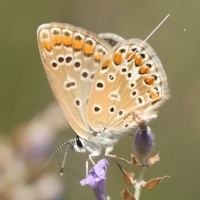 |
 |
| ref | sex |
observations |
alt. m |
| 14655 | M |
it may be common, but a fresh male still has a beautiful bright blue upperside. |
140 |
| 32771 | M | a male, the wings showing the underside markings, although not because the photograph is backlit. | 140 |
| 34490 | M | a male, bright blue but not as bright as the Adonis Blue (P. bellargus). | 20 |
| 35265 | F | a female. | 20 |
| 33060 | F | a female, with the uph almost completely blue and the upf mostly brown. | 1000 |
| 14921 | F |
a female, almost completely brown with only faint blue scaling in the uph marginal region, and strong lunules extending to s3 on the upf and a weaker lunule in s4. |
220 |
| 10707 | F |
this female is of the blue form, with extensive blue uph scaling but the full-ish set of unf lunules indicates icarus. It could be confused, from the upperside alone in early season, with the female of the first brood thersites (the second brood female is the more normal plain brown). The key differentiator (as it appears to me) seems to be that the upf orange lunules extend to the costa in icarus but only to about s3 or s4 in thersites. |
340 |
| 13682 | M |
a male, with pale brown unh ground colour and strong elongated red lunules. |
70 |
| 16867 | M |
a male with nice clean underside markings and strong bright orange lunules. |
900 |
| 17004 | M |
a male with a slightly darker unh ground colour and rather weak and rounded black chevrons lining the orange lunules. |
920 |
| 37196 | M | a very typical male, with a rather greyer, cleaner ground colour than most on this page. | 560 |
| 19853 | F |
a female, with very strong and contrasted markings, and a degree of aberration in the unf discal spots. |
140 |
| 14874 | F |
a female with very strong and pointed orange lunules and black chevrons, normally more indicative of the female Escher's Blue (P. escheri) than icarus. |
140 |
| 14917 | F |
a female, by contrast with very weak unh marginal lunules and markings generally. |
220 |
| 24675 | F | a quite dark and heavily marked female. | 220 |
| 50433 | F | a female, which appeared to be freshly emerged. It is boldly and beautifully marked, much more so than any other female icarus I have seen. Who says female blues are dull? | 280 |
| 49240 | PAIR | a mating pair, both looking very fresh, whereas the males are usually looking a little the worse for wear, and having the decency to be in the same plane so that they both fit into the very tight depth of field of the macro lens. The female is above, clearly contrasting the difference in ground colour between the sexes. | 140 |
33060_female_Alpes-Maritimes_28Jun13
16867_male_Alpes-Maritimes_27Jun09
37196_male_Alpes-de-Haute-Provence_11May15
50433_female_Côte-d'Or_27Aug22